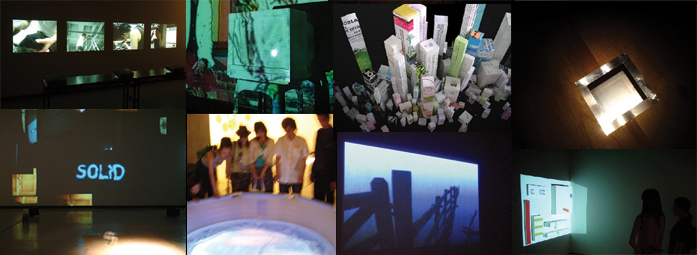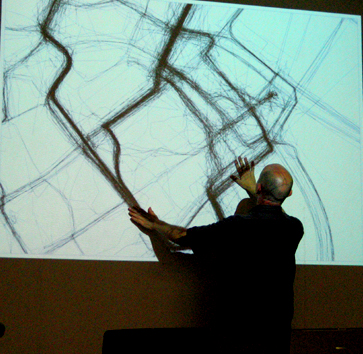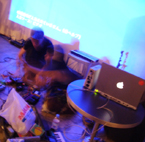traversing territories
Traversing Territories is an exchange project between Nottingham Trent University and Musashino Art University, Tokyo, first initiated in 2005. It is designed to engage students from both universities in international exchange and collaboration which allows new insight into different approaches to arts practice and education.

The format of the program has consisted of each year bringing 4 students and a professor from Tokyo to Nottingham and vice-versa for a two week period. At the host institution the guests would join with the wider student body in various discussions, workshops, lectures and collaborations. The final outputs of these dialogues are then presented in public events both within and outside of the institutions. The dialogue feeds into the wider institutions and their curriculum throughout the year, bringing benefits to the wider student body and with outcomes which the general public can share in.
The guest students are placed in quite a
challenging position of going to another country, with a different
language and different culture, entering an unfamiliar
institution, and
within a very short space of time having to
formulate some response to their context and
present this to publicly. Certainly a
challenge, but an important one to face. To be taken outside of
one’s comfort zone into unfamiliar territory where one must
adapt quickly and draw upon one's resources in order to bring forth
the most from a situation. 
This program offers a very unique opportunity for its participants and will have a lasting impact upon their practice as development as they draw from the experience and relationships built here which can benefit them for years to come.
Universities are already highly international spaces, with students of many different backgrounds, and many coming from countries around the world to study there. However there is still a need to promote further international and cultural awareness to further understanding of different contexts and conditions which will allow a broadening of perspective and approach to one's own practice too.Studying abroad is one way to engage in this process and is a very rewarding experience in which one may learn more about others and oneself, even within a short period.
collaboration

Discussion, collaboration and exchange are the main objectives of this project, the key elements which will have the most lasting impact. Communication is not just encouraged during the exchange itself but is sought to become integral to the curriculum of each institution, all year round. An online forum was established with this in mind, allowing students to be able to share their ideas, comments, images, videos and sounds concerned with their practice.
Dialogue has occurred naturally through the students’ initiation, but frameworks were also set up to encourage this process, including a number of presentations, both to the wider student group and to the general public.
This included a presentation in the 2005 exchange at the British Council, Tokyo, to inform people of the development of the project and to provide further information about the universities. Prospective students, professors, artists and those interested in exchange between Japan the UK attended this talk. This provided the participating students an opportunity to present the investigations of their practice and how the exchange contributes to these.
Close discussion between the students is fundamental to the project, developing concepts, deepening their understanding of their own investigations and widening their set of references, this is the defining element of exchange. Collaboration can take many forms from constructive dialogue to the actual creation of work together, and all these levels are valued and encouraged. Joining in discussion of ideas and cooperation on the production of their art works has resulted in joint performances and installations, contribution to individuals’ projects and a heightened awareness of each others’ practices.
Engaging in critical debate and gaining exposure to new approaches to art theory and practice is vital for any practitioner and this exchange contributes significantly to the students’ professional development, team work, communication skills, and the building of relationships, links and networks which can be drawn on for years to come.
learning

The participating lecturers in this project played a significant role in the host institution during the exchange, extending the academic program through lectures, tutorials and workshops, providing the wider student body with the opportunity to learn new skills, engage in discussion about their own work and gain an insight into the unique practices of these lecturers.
In Tokyo in 2005 Frank Abbott introduced students to new web streaming programs available on the internet, engaging students in collaborative performance. These workshops have proved very valuable in maintaining communication between the students between exchanges, as they have utilised streaming facilities to engage in creative dialogue. He also gave lectures upon old and new media and his own practice. In the 2007 exchange Rob Flint offered insight into the relationship between sound and image and introduced some of his recent projects. In 2008 Andrew Brown offered the opportunity to experiment with space and performative gestures which harmonize with or disturb the surroundings and presented his recent collaborative research project Open City.
In Nottingham Professor Christophe Charles presented to a large audience at Broadway Cinema the context of his own practice and research emphasising the relation between sound and the environment. He also gave an introductory workshop to MAX/MSP software in the Digital Arts Lab. Rob Flint and Andrew Brown (Nottingham Trent Lecturers) also ran a contrastingly ‘lo-tech’ workshop working with film manipulation and super 8 projectors. These workshops brought both Musabi and Nottingham Trent students together to learn and share skills.
Workshops

Traversing Territories is committed to widening participation in cultural exchange beyond the institution. It was with this objective that workshops were held by the students themselves for local children in both Tokyo and Nottingham. This extended the impact of the project to a wider audience, engaging with and contributing to the local community. This was a valuable opportunity for students and school children to interact with each other, learn new skills and be encouraged in cultural understanding.
In Tokyo local children were encouraged to re-examine their own environment and begin to compare that with the area of Nottingham which they could only experience through visual representations. Using video and sound recording equipment they documented their surroundings from their own perspective. This was then merged with inspiration taken from the photos of Nottingham and painted sculptural forms were created.
In Nottingham a number of the students participating in the exchange project contributed to an animation workshop in Seagrave Primary School. This introduced a variety of animation techniques and also allowed the children to create their own animations through hand drawn cell animation and stopmotion animation. In this workshop elements of Japanese culture were introduced. Children were shown examples of Japanese animation and manga, while also referring to traditional performance and art.
Exhibition

Presenting work to the public, a new audience, gaining exposure and feedback in a new environment was of great benefit to the participating students. This opportunity gave them valuable experience contributing to their professional development. The work of Musabi and Nottingham Trent students was presented alongside each other and in many cases was the result of direct collaboration. This enabled the students to appreciate their different approaches to art practice.
In Japan exhibitions have taken place in the vast hall of Musabi, the contrastingly cosy space of Gallery Jin, Yokohama, dontown art space Hiroge and in the vibrant area of Shibuya. In the UK a joint exhibition has been held at the 1851 Gallery, in the historic Waverley Building and the Bonington Gallery, Nottingham as well as venues in London. The students had to adapt to the space and environment of these galleries, all of different scales and structures. They proved their diverse talents through the eclectic and innovative works presented in these events including: sound, video, interactive installation, photography and sculpture.
live events

Many of the participating students incorporated a strong performative element to their work which was presented in a series of live events. The immediate nature of these presentations allowed a wide scope for collaboration in which the live dialogue between the artists formulated the performance itself. The direct spontaneity of these performances gave them an exciting impetuous.
In Tokyo live events have taken place at the opening and closing of the exchange exhibitions and also at the well known arts space Superdeluxe. In Nottingham students have also been given many opportunities to present live work, in the opening of the exhibitions but also in the wider events of Trampoline and NODE.London. At Trampoline – Nottingham’s platform for new media art – the students were able to present their works amongst leading new media artists from the region, the wider UK and other international participants, in an event packed with video, interactive installation, web art, music and performance. The spirit of collaboration was exemplified by a karaoke duo between Musabi student Tomoyuki Yago and NTU lecturer Alain Ayers. Students also presented in NODE.London, the pioneering London wide new media festival, allowing the experience of showing work in the capital, in yet another environment, in a dedicated event of the students performance.
overview
2005 Mike Lomon, Johnny Scarr, Amy Fisher, Rosy Pickles
Musashino Art University, Superdeluxe, Gallery Jin, Children’s workshop
2006 Lynn Lu, Koyanagi Junji, Nagao Yuichi, Tomizawa Takami
1851 Gallery, Trampoline, NODE.London, Children’s workshop
2007 Ashley, Matthew, Jen, Toby
Musashino Art University, Superdeluxe, Higure
2008 Koiso Lisa, Kim Hoonida, Son Woo Kyung, Watanabe Yasutaka
Bonington Gallery, Cameleon, Vortex
2008 Sarah, Daniel Cervi, Martin, Alia
Musashino Art University, Superdeluxe, Le Deco
2009.....
comment
The importance of international engagement,in particular in the field of art and education, can not be stressed enough.
Participating in dialogue with those working in a different environment, with a different set of references and experiences is invaluable to the development of one’s practice. The sharing of different perspectives, different methodologies and a different art currency raises an awareness of the enormous variety in this field, which is exciting and inspiring.
Entering into a new context, pursuing communication and facing the challenges of such a situation opens one’s eyes to many new possibilities and strengthens one’s determination, excelling resourcefulness, initiative and cultural understanding. Professional development is also stimulated through contribution to public events engaging with a new audience and providing new responses on one’s work.
It is not just one or two students who benefit from a project such as this, it feeds into the wider student community and the universities as a whole. A large range of events taking place energetically in a concentrated period of time in which participation is highly encouraged. Its impact is not merely enclosed within the institutions either, it extends itself into the cultural life of the city, informing a wide public audience through the vigorous outputs of the project.
Exchange, sharing and cooperation between universities internationally is of enormous benefit to all involved and extends the dynamism of the learning environments. This project offers a clear example of how international dialogue can be integrated into the fabric of the education program while also extending beyond it.








